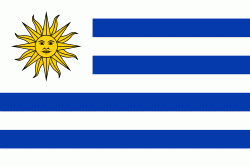Barros Blancos (Barros Blancos)
Barros Blancos is a city in the Canelones Department of southern Uruguay. In 1976, it had been renamed to Juan Antonio Artigas, after commanding officer Juan Antonio Artigas, grandfather of the national hero José Gervasio Artigas, but the old name was reinstated in 2007.
Barros Blancos is also the name of the municipality to which the city belongs and which includes the two fragments of Camino Maldonado and some surrounding rural areas.
The city is located on Route 8, northeast by road from Montevideo, on the road to Pando, also north of Colonia Nicolich and southwest of Toledo and Joaquín Suárez. It forms a southwestern extension of the urban area of Pando. They all belong to the wider metropolitan area of Montevideo.
Barros Blancos is also the name of the municipality to which the city belongs and which includes the two fragments of Camino Maldonado and some surrounding rural areas.
The city is located on Route 8, northeast by road from Montevideo, on the road to Pando, also north of Colonia Nicolich and southwest of Toledo and Joaquín Suárez. It forms a southwestern extension of the urban area of Pando. They all belong to the wider metropolitan area of Montevideo.
Map - Barros Blancos (Barros Blancos)
Map
Country - Uruguay
 |
 |
| Flag of Uruguay | |
The area that became Uruguay was first inhabited by groups of hunter–gatherers 13,000 years ago. The predominant tribe at the moment of the arrival of Europeans was the Charrúa people, when the Portuguese first established Colónia do Sacramento in 1680; Uruguay was colonized by Europeans late relative to neighboring countries. The Spanish founded Montevideo as a military stronghold in the early 18th century because of the competing claims over the region. Uruguay won its independence between 1811 and 1828, following a four-way struggle between Portugal and Spain, and later Argentina and Brazil. It remained subject to foreign influence and intervention throughout the 19th century, with the military playing a recurring role in domestic politics. A series of economic crises and the political repression against left-wing guerrilla activity in the late 1960s and early 1970s put an end to a democratic period that had begun in the early 20th century, culminating in the 1973 coup d'état, which established a civic-military dictatorship. The military government persecuted leftists, socialists, and political opponents, resulting in deaths and numerous instances of torture by the military; the military relinquished power to a civilian government in 1985. Uruguay is today a democratic constitutional republic, with a president who serves as both head of state and head of government.
Currency / Language
| ISO | Currency | Symbol | Significant figures |
|---|---|---|---|
| UYU | Uruguayan peso | $ | 2 |
| ISO | Language |
|---|---|
| ES | Spanish language |















